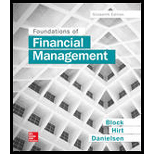
Concept explainers
a.
To calculate: The number of warrants that can be purchased at $1,000 by Mr. John Hailey.
Introduction:
Warrant:
It is a security that provides its holder with an entitlement of buying the underlying shares of a corporation at a price fixed by it.
b.
To calculate: The total dollar gain and percentage return of Mr. John Hailey on the stock, if the price of the stock goes to $40.
Introduction:
A rate that shows the net profit or loss, an investor earns or loses on the investment over a particular time period is termed as the rate of return.
Profit or Loss:
It refers to the gain or loss arising from the commercial transactions during a specified period of time and is used to assess the company’s financial performance.
c.
To calculate: The total dollar gain and percentage return of Mr. John Hailey on the warrant, if the stock price goes to $40.
Introduction:
Rate of return (ROR) :
A rate that shows the net profit or loss, an investor earns or loses on the investment over a particular time period is termed as the rate of return.
Profit or Loss:
It refers to the gain or loss arising from the commercial transactions during a specified period of time and is used to assess the company’s financial performance.
d.
To calculate: The price of stock at speculative premium at $3.50 over the intrinsic value.
Introduction:
Share price:
The highest price of one share of a company that an investor is willing to pay is termed as the share’s price. It is the current price used for the trading of such shares.
Want to see the full answer?
Check out a sample textbook solution
Chapter 19 Solutions
Foundations of Financial Management
- finance subjectarrow_forwardCould you help explain, what is the complete salary survey analysis, and ensuring the data is relevant and up-to-date? What is the job evaluation and compensation plan? How to ensure the final report is comprehensive, clearly structured, and aligned with the company vision?arrow_forwardThe maturity value of an $35,000 non-interest-bearing, simple discount 4%, 120-day note is:arrow_forward
- Carl Sonntag wanted to compare what proceeds he would receive with a simple interest note versus a simple discount note. Both had the same terms: $18,905 at 10% for 4 years. Use ordinary interest as needed. Calculate the simple interest note proceeds. Calculate the simple discount note proceeds.arrow_forwardWhat you're solving for Solving for maturity value, discount period, bank discount, and proceeds of a note. What's given in the problem Face value: $55300 Rate of interest: 10% Length of note: 95 days Date of note: August 23rd Date note discounted: September 18th Bank discount rate:9 percentarrow_forwardAll tutor giving incorrect solnarrow_forward
 Individual Income TaxesAccountingISBN:9780357109731Author:HoffmanPublisher:CENGAGE LEARNING - CONSIGNMENT
Individual Income TaxesAccountingISBN:9780357109731Author:HoffmanPublisher:CENGAGE LEARNING - CONSIGNMENT





